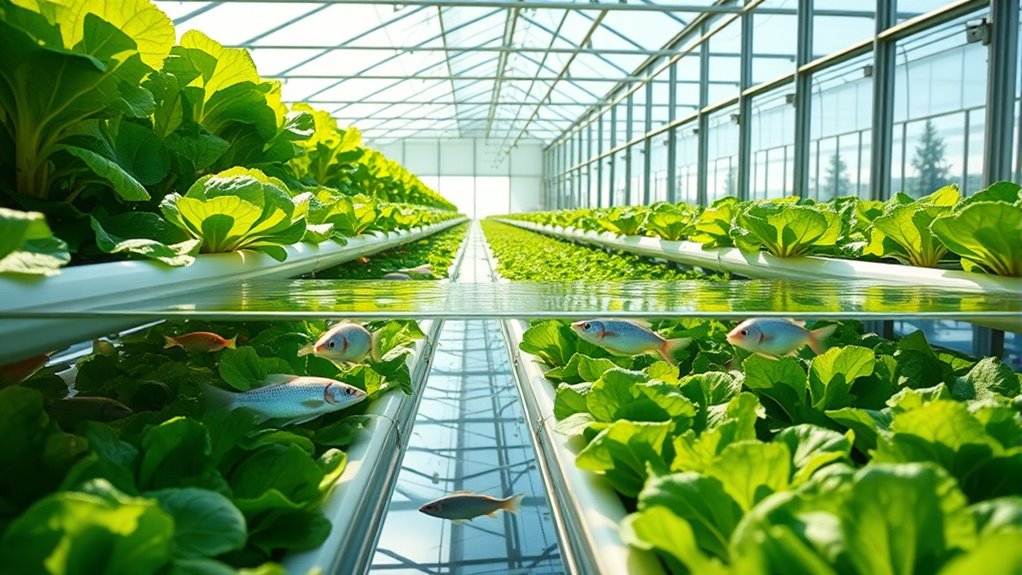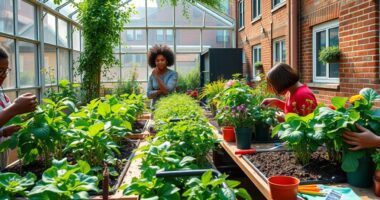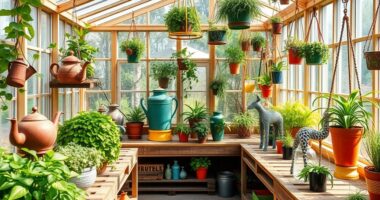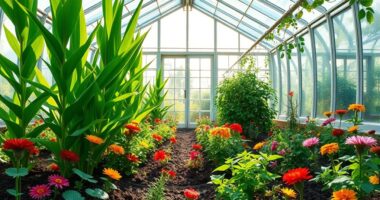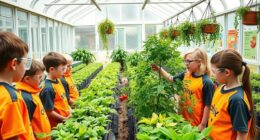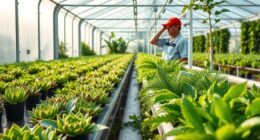You can learn that Gunni Gal Farms created their year-round aquaponic greenhouse by integrating sustainable farming methods that combine fish and plant cultivation. They design their greenhouse with features like maximizing natural light, managing temperature, and regulating humidity to maintain a stable environment. Proper water circulation and fish health management are key to their success. If you keep exploring, you’ll discover how these elements come together to guarantee continuous, eco-friendly production.
Key Takeaways
- Gunni Gal Farms integrated sustainable aquaponics, combining fish farming and plant cultivation for continuous, year-round harvests.
- They designed a greenhouse with strategic lighting, shading, and climate controls to stabilize temperature and humidity.
- Regular water quality testing and fish health management ensured optimal conditions for both aquatic life and plants.
- Efficient water circulation systems minimized energy use and prevented dead zones, enhancing system stability.
- The greenhouse’s insulation and climate control features maintained consistent environmental conditions, supporting year-round production.
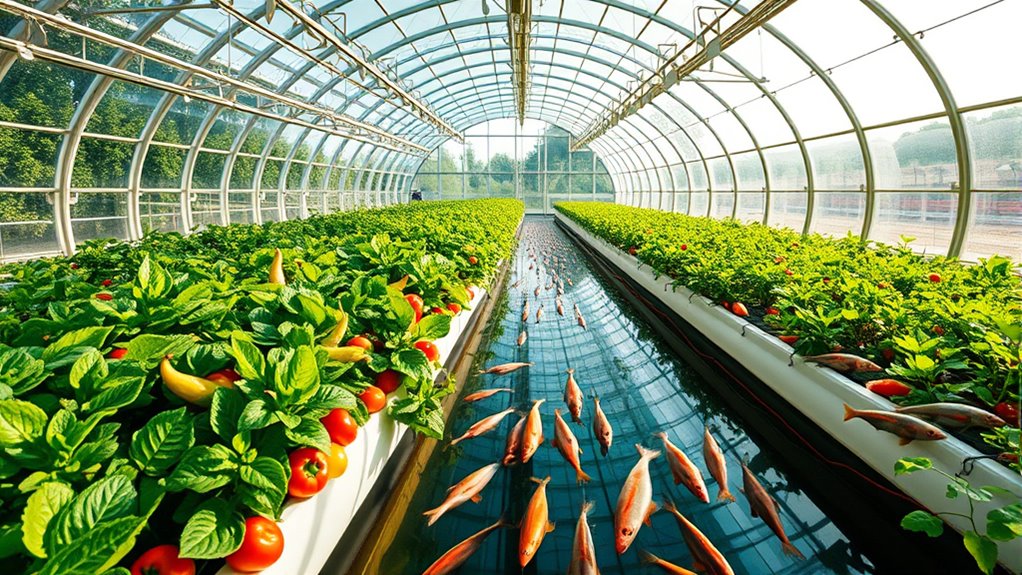
Gunni Gal Farms Aquaponic Greenhouse is transforming sustainable agriculture by combining fish farming and plant cultivation in a single, efficient system. This innovative approach allows you to grow fresh produce year-round while simultaneously raising fish, creating a symbiotic environment that benefits both. To guarantee the success of this system, paying close attention to fish health is essential. Healthy fish are the foundation of a thriving aquaponic setup, as they produce the nutrients that feed your plants. You need to monitor water quality consistently, keeping parameters like pH, ammonia, nitrites, and nitrates within ideal ranges. Regular testing and adjustments prevent stress and disease among your fish, which could otherwise compromise your entire operation. Maintaining proper oxygen levels and temperature also plays a key role in supporting fish health, ensuring that your aquatic livestock remain active and resilient.
The greenhouse design at Gunni Gal Farms is meticulously crafted to support these needs. You benefit from a structure that maximizes natural light, with strategically placed vents and shading to regulate temperature and humidity. A well-designed greenhouse minimizes temperature fluctuations, creating a stable environment that supports consistent plant growth and keeps your fish comfortable. The layout facilitates efficient water flow, with gravity-fed or pump-driven systems that reduce energy consumption and streamline maintenance. Proper circulation prevents dead zones, ensuring oxygen and nutrients are evenly distributed throughout the system. Additionally, the greenhouse incorporates insulation and climate control features that extend the growing season, allowing you to produce crops year-round regardless of external weather conditions. This design also helps maintain steady water temperatures, which are essential for fish health and plant vitality.
Furthermore, understanding how to get a divorce can be relevant if managing emotional stress during the setup process, as clear legal guidance can help you focus on your sustainable farming goals. You’ll find that integrating thoughtful greenhouse design with diligent fish health management results in a resilient, productive system. By controlling environmental factors through your greenhouse, you reduce the risk of disease and stress in your aquatic animals, leading to healthier fish and more robust plant growth. The design also simplifies routine tasks such as feeding, water testing, and system monitoring, giving you more time to focus on maximizing yields. Overall, Gunni Gal Farms demonstrates that careful planning, from greenhouse design to fish care, is key to creating a sustainable, year-round aquaponic operation. This approach not only guarantees consistent harvests but also promotes eco-friendly practices that benefit the environment and your bottom line.
Frequently Asked Questions
What Are the Initial Costs to Start an Aquaponic Greenhouse?
You’ll need around $10,000 to $50,000 to start your aquaponic greenhouse, depending on size and technology. This investment covers setup costs, equipment, and initial supplies. While the upfront costs are significant, the economic feasibility improves with sustainable practices that reduce ongoing expenses. Incorporating eco-friendly systems enhances sustainability, ensuring your greenhouse remains profitable and environmentally responsible over time.
How Does Gunni Gal Farms Ensure Fish Health Year-Round?
Think of water quality as the bloodstream of your aquaponic system; it’s essential for fish health. You guarantee year-round health by constantly monitoring fish and adjusting water parameters. Gunni Gal Farms uses real-time sensors and regular checks to detect issues early, preventing disease and stress. This vigilance keeps fish thriving, no matter the season, turning their greenhouse into a resilient ecosystem where healthy fish flourish consistently.
What Types of Plants Are Most Successful in the Greenhouse?
You find that tropical fruits and medicinal herbs thrive best in the greenhouse. The warm, controlled environment mimics their native climates, allowing you to grow varieties like bananas, pineapples, and herbs such as basil and mint year-round. These plants benefit from the consistent temperature and nutrient-rich water, making them highly successful. By focusing on these, you maximize your greenhouse’s productivity and enjoy fresh, organic produce and herbs throughout the year.
How Is Energy Efficiency Managed During Different Seasons?
Think of your greenhouse as a living, breathing entity that adapts with the seasons. You optimize energy efficiency by harnessing solar power through strategic solar optimization, ensuring maximum sunlight during winter and shade in summer. Insulation techniques like double glazing and thermal curtains keep warmth in and cold out. This balance helps reduce energy costs and keeps your plants thriving year-round, no matter what Mother Nature throws your way.
What Challenges Are Faced in Maintaining Aquaponic Balance?
You face challenges in maintaining aquaponic balance, especially with pest management and water quality. Pests can weaken plants and disrupt the system, so you need vigilant monitoring and natural control methods. Water quality is critical; you must regularly test and adjust nutrient levels, pH, and oxygen to keep fish and plants healthy. Balancing these factors guarantees your aquaponic system runs smoothly year-round, preventing system crashes.
Conclusion
You’ve seen how Gunni Gal Farms created a year-round aquaponic greenhouse, blending innovation with sustainability. You’ve witnessed the seamless integration of fish and plants, the efficiency of controlled environments, and the potential for local food production. You’ve understood how technology, nature, and ingenuity work together to transform farming. Now, imagine applying these principles in your own life, embracing sustainability, harnessing technology, and cultivating resilience—all through the power of aquaponics.
